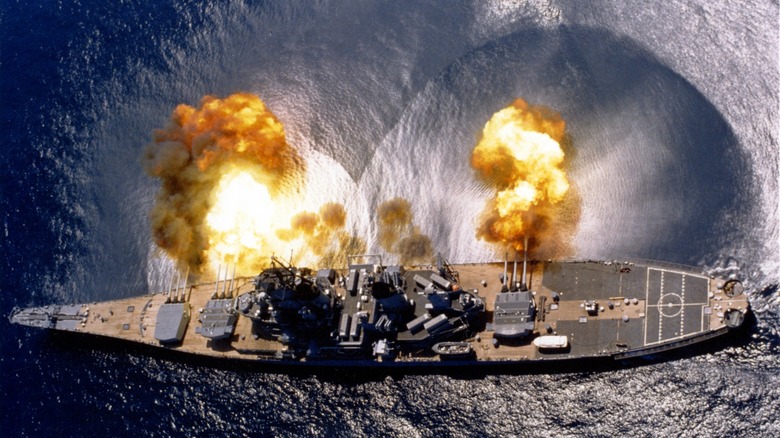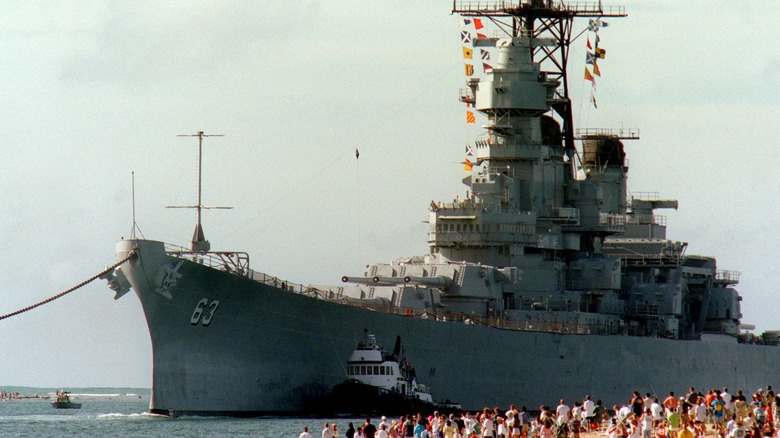How Big Were Iowa-Class Battleships And How Many Troops Could They Carry?
During the lead-up to the United States' entry into World War II, the U.S. Navy ordered six new battleships that were designed to combat Japan's Kongō-class battleships. Ultimately, only four of the planned six vessels were completed, and each of them engaged in combat operations during and after the war. Because of their size and the incredible amount of firepower the Iowa-class battleships brought to the fight, they've become some of the most storied and beloved warships the U.S. Navy has ever operated.
Due to advancements in missile technology, the U.S. military stopped using battleships, rendering them a relic of a bygone era. But while they sailed, they did so as some of the most powerful warships in the Navy's arsenal. It's difficult to understand just how massive an Iowa-class battleship was without standing before one, but you can rest assured, they were huge ships. Each one displaced 58,460 tons of seawater when fully loaded. While this was less than the now-sunken Japanese Yamato battleship, which displaced 72,800 tons, the Iowa-class battleships' smaller size made them faster, which was the Navy's intent.
Iowa-class battleships weren't intended for troop transport, so they weren't in the habit of taking personnel to and from combat zones. That said, they were heavily manned, especially during World War II. During the conflict, 134 officers and 2,400 enlisted sailors crewed each battleship. The number was significantly reduced during Operation Desert Storm to 65 officers, 1,450 enlisted sailors, and 58 marines. This was mostly due to advancements in technology, which required fewer personnel to operate.
The Iowa-class Battleships of World War II
Each of the four commissioned Iowa-class battleships was a large vessel primarily used as a fast escort for the Navy's Essex-class aircraft carriers during WWII. They served in this capacity well, thanks to their massive guns, which made them such devastating warships. When they were initially constructed, Iowa-class battleships, such as the USS Iowa, boasted nine 16-inch guns, 20 five-inch guns, 76 40mm anti-aircraft guns, and an additional 52 20mm anti-aircraft guns. They had the power to project force well into a shoreline's defenses, and they could protect themselves from airborne threats.
The vessels measured 887 feet long, utilized eight boilers to turn their four screws, and could achieve a maximum speed of 38 mph, with a range of 17,135 miles. Battleships also boasted armor, measuring between 1.5 and 17.3 inches in thickness. When the Navy upgraded them to serve in more modern conflicts, such as the Gulf War, battleship armaments changed significantly.
Most notably, they featured 32 Tomahawk cruise missiles, 16 RGM-84 Harpoon anti-ship missiles, and four 20mm Phalanx Close-In Weapons Systems for defense. The ships also retained the main guns but had fewer five-inch guns (12 instead of 20). These modernized weapon systems adapted the battleships for a more complex and deadly battlespace, ensuring their survivability for as long as possible. Additionally, while Iowa-class battleships initially carried three floatplanes, they later carried two to four helicopters in Korea and Vietnam. For the Cold and Gulf Wars, they were home to five RQ-2B Pioneer UAVs.
You can visit all four Iowa-class battleships
The only way to truly understand the size and scope of an Iowa-class battleship is to see one for yourself. Fortunately, all four — the Iowa, New Jersey, Missouri, and Wisconsin — survived their combat deployments and were converted into museum ships. The USS Missouri was the last of America's battleships to serve before her retirement in 1992. She was turned into a museum in 1998, and you can visit the mighty military vessel the next time you're near the Pearl Harbor Memorial in Hawaii.
The USS Iowa, the first of her class, was decommissioned in 1990, having achieved numerous victories in combat operations worldwide. In 2011, she was moved to a permanent location at the Port of Los Angeles, where she remains open to the public as the USS Iowa Museum. The USS New Jersey served during WWII, the Korean War, and the Vietnam War, before undergoing a modernization upgrade years later. She was decommissioned in 1991 and became a museum ship in Camden, New Jersey.
Finally, the USS Wisconsin served throughout the 20th century, retiring after Operation Desert Storm. She was decommissioned in 1991 and was later donated to the city of Norfolk, Virginia, where she operates as a museum. Thanks to their spread-out locations, you can visit an Iowa-class battleship on the east and west coasts of the continental United States, as well as in Hawaii, giving as many people as possible the opportunity to see one in the flesh.


